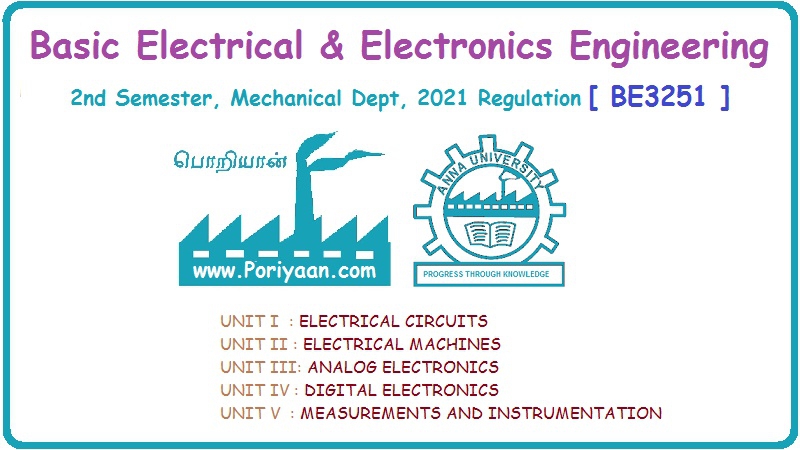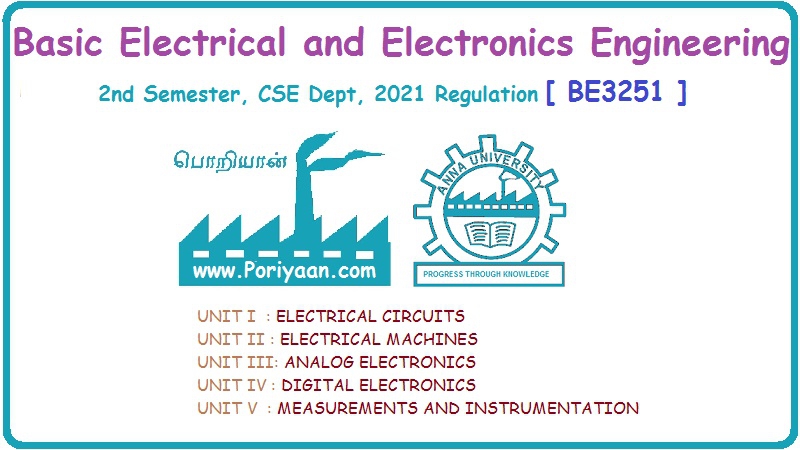Basic Electrical and Electronics Engineering: Unit II: Electrical Machines
Constructional Details of DC Generator
The major parts of the DC generator is given below and also shown in fig.2.2. 1. Magnetic frame or yoke 2. Poles, interpoles, windings, pole shoes 3. Armature 4. Commutator 5. Brushes, bearings and shaft
CONSTRUCTIONAL
DETAILS
The
major parts of the DC generator is given below and also shown in fig.2.2
1.
Magnetic frame or yoke
2.
Poles, interpoles, windings, pole shoes
3.
Armature
4.
Commutator
5.
Brushes, bearings and shaft
Yoke
The
outer frame or yoke serves two purposes.
(i)
It provides mechanical support for the poles and acts as a protecting cover for
the whole machine.
(ii)
It carries the magnetic flux produced by the poles.
In
small machines where cheapness is the main consideration and weight is not a
critical factor. The yoke is made up of cast iron. But for larger machines cast
steel or rolled steel is used.
Poles
The
poles consist of pole cores, pole shoes and pole coils. The pole cores and pole
shoes form the field magnet. The pole shoes used to spread out the flux in the
air gap and also reduce the reluctance of the magnetic path. The pole shoes
also support the exciting coils or field coils. The pole core is made up of
cast iron or cast steel. To minimize the eddy current losses the pole cores and
pole shoes are laminated. Annealed steel is used for laminations. The thickness
of laminations varies from 1 mm to 0.25 mm.
The
pole coils are made up of copper wire or strip. When current is passed through
these coils, the pole becomes an electromagnet and starts establishing a
magnetic field in the machine. The flux distribution through the pole, air gap,
armature core and yoke is shown in fig.2.3.
Interpoles
In
modern DC machines commutating poles or interpoles are provided to improve
commutatation. Like the field winding the commutating poles also have exciting
coils which are connected in series with the armature.
Armature
The
armature consists of an armature core and armature windings. The armature core
houses the armature conductors or coils and causes them to rotate and cut the
magnetic flux of the field magnets.
The
armature core is cylindrical or drum shaped. It is made up of circular sheet
steel. The armature core is laminated with the thickness of 0.5 mm. the
lamination is used to minimize the eddy current loss. The laminations are known
as stampings. In small machines these stampings are directly keyed on the
shaft. In larger machines the stampings are first assembled and then keyed on
an armature spider and the armature spider is then keyed on to the shaft.
The
armature conductors are housed in the slots. The slots are rectangular in shape
for large machines and circular for small machines.
The
conductors are housed in slots in two layers. The slots are closed by fiber or
wooden wedges to prevent the conductors from flying out due to centrifugal
force when the armature rotates. The arrangement is shown in fig.2.3 and 2.4.
Commutator
The
function of commutator is collection of current from the armature conductors
and converts the alternating current induced in the armature conductors into
unidirectional current in the external load circuit. It is cylindrical in
structure and is built up of wedge shaped segments of high conduction
hard-drawn copper. These segments are insulated from each other by thin layers
of mica. The number of segments is equal to the number of armature coils.
Each
commutator segment is connected to the armature conductor by means of a copper
lag or strip or riser. To prevent them from flying out under the action of
centrifugal forces, the segments have V-grooves, these grooves are insulated by
conical micanite rings. The cross sectional view of commutator is shown in
fig.2.5.
Brushes
and Bearing
The
brushes are made up of carbon or graphite. The function of brushes is collect
the current from the commutator and conveys the current in to the external load
resistance. They are rectangular in shape. These brushes are housed in brush-
holders and mounted over brush holder studs. The brush holder studs are mounted
on a brush yoke. The brush holder studs are insulated from the brush yoke by
insulation sleeves.
Ball
bearings are used for light machines and for heavy machines roller bearings are
used. The bearings are packed in hard oil for quieter operation.
Basic Electrical and Electronics Engineering: Unit II: Electrical Machines : Tag: : - Constructional Details of DC Generator
Related Topics
Related Subjects
Basic Electrical and Electronics Engineering
BE3251 2nd semester Mechanical Dept | 2021 Regulation | 2nd Semester Mechanical Dept 2021 Regulation
Basic Electrical and Electronics Engineering
BE3251 2nd Semester CSE Dept 2021 | Regulation | 2nd Semester CSE Dept 2021 Regulation

